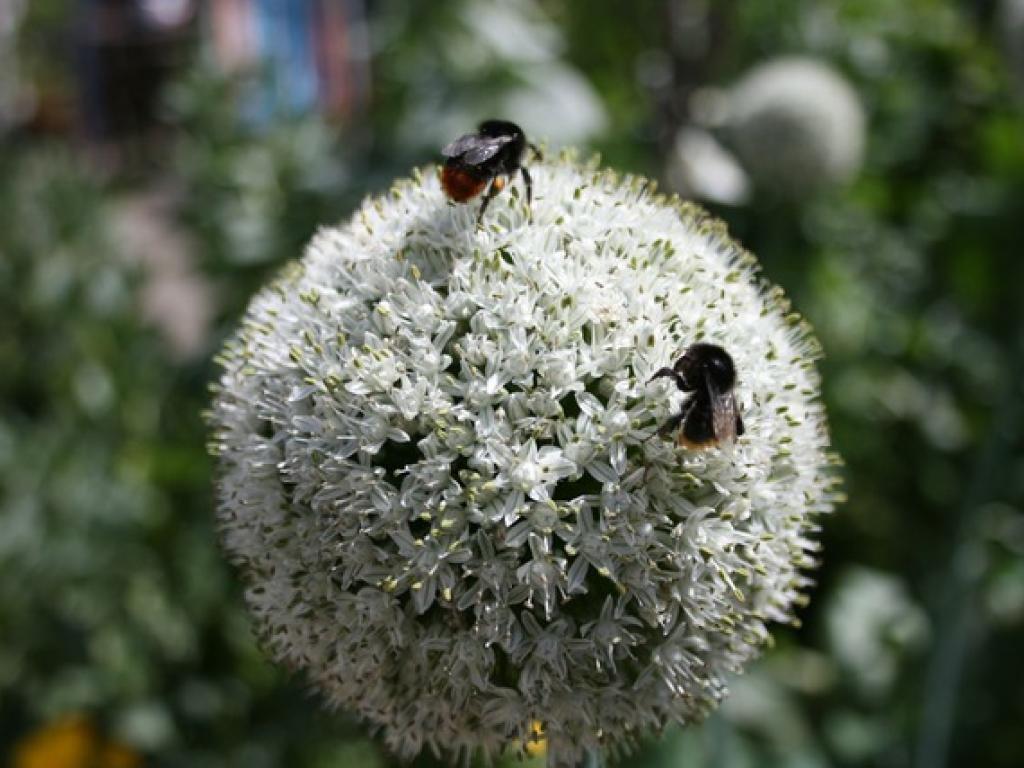To bee or not to bee

By Christopher Brodrick
Before coming to the ACDI, I worked as a research assistant to an entomologist at the South African National Biodiversity Institute (SANBI). One of our projects involved sampling the number and species of pollinators found on onion flowers on Karoo farms near De Rust and Klaarstroom (small towns close to Oudtshoorn). We would walk up and down the rows of flowering onions, with my supervisor calling out the species and number of pollinating insects that he saw while I wrote this down on the clipboard.
These onions are grown for seeds and not for local consumption; at the end of the season, representatives of multinational trading companies visit the farms to assess the germination rate of harvested seeds. If the germination rate exceeds the requisite threshold, vast quantities of the seeds are exported to the high-paying markets of Japan and Europe, where they are grown for consumption.
If the threshold is not exceeded, however, the seed crop is effectively useless – no one will buy it. It’s an all or nothing situation. Successful pollination is essential for high germination rates, and bees are one of the chief pollinators of onions. It is likely that climate change – both natural variability and increasing temperatures – will negatively affect pollination rates in some areas.
Honeybees begin laying eggs when outside temperatures warm up enough for them to maintain a warm temperature inside the hive. Provided that the worker bees can maintain the necessary temperature, the eggs will grow into adults in approximately three weeks. If the climate becomes more variable, and a cold snap intervenes in this period, many eggs may die, decreasing the colony size substantially. If this occurs, the colony has to start the process again1. Following an unsuccessful breading period, flowering occurs before the worker bee population is sufficient, leading to less pollination, and not enough honey being stored by the bees to get them through the winter. Thus, bee numbers the following year also decrease 1.
According to biodiversity researchers such as Michael Kuhlmann, due to the high endemism, the Mediterranean climate and the small range sizes in the Cape Floristic Region (CFR) of the Western Cape, bee fauna have been identified as being especially vulnerable to climate change 2. According to species distribution projections (using A2 and B2 climate scenarios of the HadCM3 model) 2, most bee species in the CFR are set to move eastwards into the drier interior, with their spatial range also decreasing in size 2. This poses serious concerns for both conservationists and farmers alike, particularly in the fringe regions of the CFR (such as the De Rust and Klaarstroom areas mentioned above).
I find that often when one thinks of bees, images that come to mind are of bees landing on flowers – whether it be a spider orchid or an onion flower. But bees also are also mad about the honeydew found on large trees. In December last year, I went to the Groot-Winterhoek Mountains above Porterville, where we pitched our tents under a large oak tree. We awoke early in the mornings to the sound of thousands of bees foraging for honeydew on the oak tree, and in the process dropping tiny particles of it onto the flysheets of our tents, making them slightly sticky. I hoped that the stickiness would improve the waterproofing of my tent, without reducing the breathability of my flysheet!
Many plants and pollinators are beginning to show different temporal responses to climate change, with warming likely to increase the timeline between pollinator emergence and flowering plant emergence. 3This lack of synchronisation is a serious concern, particularly when staple crops are concerned. Turnips, pumpkins, a variety of fruits, as well as onions are heavily reliant on bees for pollination.5 According to Melin and others, this is important considering that the Western Cape fruit industry is worth R9 800 million per year! Therefore, climate induced changes to plant-pollinator synchronisation, particularly in developing countries, could in fact result in malnutrition and starvation.
Acknowledgements:
Thanks to Annalie Melin (PhD candidate, SANBI) for assisting me with the bee content of this blog.
References:
1 http://earthobservatory.nasa.gov/Features/Bees/bees3.php
2 Kuhlmann M, Guo D, Veldtman R, Donalson JS. Consequences of warming up a hotspot: species range shifts within a centre of bee diversity. Diversity Distrib. 2012;1-13.
4http://en.wikipedia.org/wiki/List_of_crop_plants_pollinated_by_bees
5 Melin A, Rouget M, Midgley J, Donaldson JS. Pollination ecosystem services in South African agricultural systems. S Afr J Sci. 2014;110(11/12), Art. #2014-0078, 9 pages. http://dx.doi.org/10.1590/ sajs.2014/20140078
Thumbnail: http://pixabay.com/en/bee-onion-flower-plant-organic-2726/